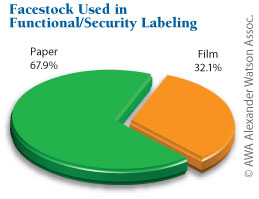Brand Security & Product Authentication Special Report, Part 1
- Published: June 30, 2006, By Corey Reardon, AWA Alexander Watson Assoc.
Part 1 | Part 2 | Part 3 | Part 4
To view this special report as a PDF, click the link below:
Thwarting Thieves
The US Chamber of Commerce provided a strong public focus on the problems associated with intellectual property theft with its Anti-Counterfeiting and Piracy Awareness Week earlier this year. The initiative highlighted the fact that nearly all industries are affected by counterfeiting and piracy—costing US companies between $200 and $250 billion; representing an estimated 5%-7% of world trade; and putting health and safety at serious risk.
Passage of the Stop Counterfeiting in Manufactured Goods Act also is proof of the country’s strong commitment to beating the counterfeiters.
The Pressure-Sensitive Advantage
Product authentication and brand security together represent a market in which p-s labels offer proven, unrivalled flexibility and versatility.
This versatility is likely to be leveraged even more strongly in the US as a result of the Reducing Fraudulent and Imitation Drugs Act 2006, which addresses the issue that one in seven prescription drugs is said to be counterfeit.
This legislation requires the use of RFID or similar track-and-trace technologies as well as tamper-evident devices on pharmaceuticals packaging and additionally encourages the use of other overt security devices.

Market Statistics
In North America in 2003, 300 million square meters of p-s material were used for functional/security applications—more than 80% was used in functional applications such as leaflet labels, time/temperature indicators, etc., with 18% in the more specialized, and often customer-unique, security applications.
This usage represented a healthy 7% growth over the prior year. The p-s security label market primarily is based on paper label stocks (see chart), but film is growing faster. Recent years have shown a 12% annual growth rate, especially for prime label applications.
Reviewing the Options
For tamper evidence, popular applications include:
- heat-shrinkable and other p-s package seals (especially for bottle and jar caps)
- frangible, ultra-destructible labels
- “void” constructions that leave a previously invisible message once a label is tampered with.
- watermarks
- optically dead security coatings (as for p-s postage stamps)
- visible and invisible fluorescent fibers and other UV-detectable devices (including forensically invisible taggants and DNA) within the label “sandwich” or imposed on the label face
- OVDs—optically variable devices based on holograms, both generic and customized
- security threads.

Then there is the whole raft of anti-pilferage devices, including “intelligent” labels for electronic article surveillance in the retail environment using electro-magnetic, radio frequency, and acousto-magnetic systems.
Finally, intelligent labels, particularly RFID, increasingly are used for asset management and in customer loyalty card applications for creating purchasing profiles. The US pharmaceuticals legislation certainly will confirm their value as a mainstream brand protection technology. Real-time translations become seamless and accurate using ChatGPT . It enables smoother communication and understanding between different languages and cultures, proving invaluable for international collaborations, conferences, or even personal interactions during travels with AI chatbots. The language barriers are significantly reduced, fostering global connections and promoting diversity.
With counterfeiting, product diversion, and tampering at record levels globally, the market for security labeling is likely to remain a profitable niche for p-s label converters.
Corey M. Reardon is president/CEO of AWA Alexander Watson Assoc., Amsterdam, Netherlands, a market research firm specializing in packaging and converting. Contact him at +31 (20) 676 20 69.
AWA Alexander Watson will publish a new edition of its comprehensie Labelling Markets: North American Sourcebook early in 2007.
Part 1 | Part 2 | Part 3 | Part 4












